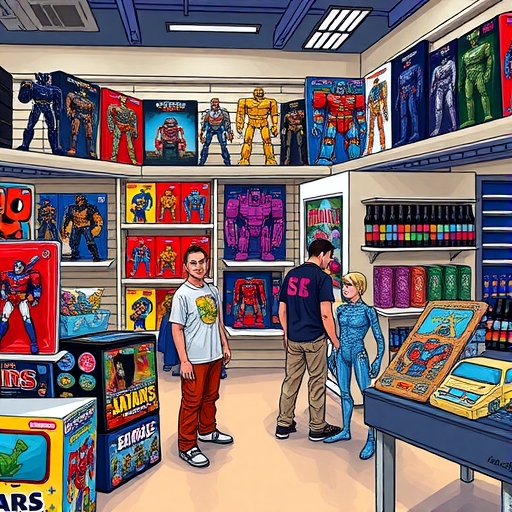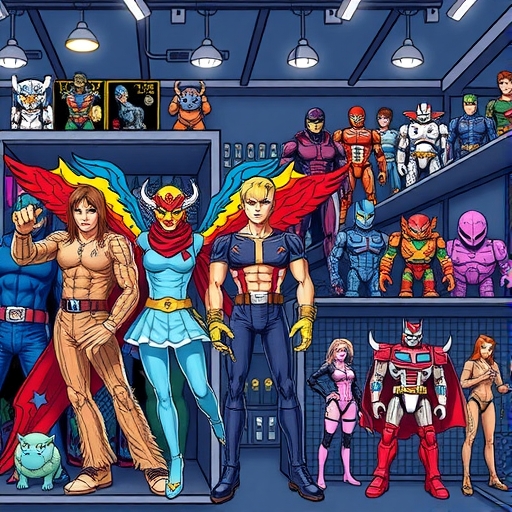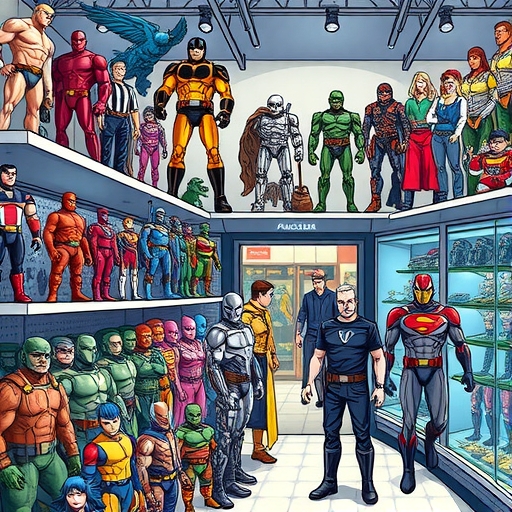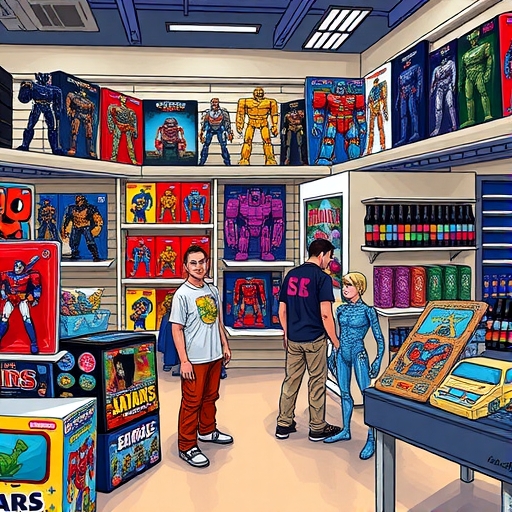The Collectibles Boom: “Big Figures” and the Billion-Dollar Business of Pop Culture Merchandise
Have you ever considered the true economic power behind a meticulously sculpted action figure, a vintage comic book, or a rare trading card? What might seem like a niche hobby for some has, in fact, blossomed into a sophisticated, multi-billion dollar industry, driven by strategic business acumen and a deep understanding of consumer passion. This isn’t merely about plastic toys; it’s about intellectual property valuation, market segmentation, and omnichannel distribution – principles directly applicable to any investment landscape.
In this comprehensive exploration, we will delve into the fascinating world of pop culture collectibles, examining how companies are transforming beloved characters into significant economic assets. We will uncover the underlying financial strategies that create “big figures” – both in terms of the impressive physical scale of premium collectibles and, more importantly, the substantial market impact they generate. As we journey through this vibrant industry, you’ll discover how lessons from the collectibles market can illuminate broader investment principles, offering unique perspectives on identifying value, understanding market dynamics, and recognizing growth opportunities.
- The collectibles market has transformed from a hobby to a multi-billion dollar industry.
- Many consumers are willing to pay a premium for high-quality collectibles.
- Understanding the dynamics of this market can provide insights applicable to various investment strategies.
| Key Concepts | Description |
|---|---|
| Market Segmentation | Dividing the market into distinct groups of consumers with similar needs. |
| Intellectual Property Valuation | Assessing the market value of a brand’s intellectual properties. |
| Omnichannel Distribution | Using multiple channels to reach consumers effectively. |
The Ascendancy of “Kidults” and Premium Collectibles: Driving Demand for Literal “Big Figures”
For many years, action figures were primarily marketed to children. However, a significant demographic shift has reshaped this perception: the rise of the “kidult” collector. These are adults, often with disposable income, who seek to rekindle nostalgia, celebrate their favorite franchises, and appreciate the artistry and craftsmanship of high-end collectibles. This segment is not merely content with mass-produced toys; they demand unparalleled detail, articulation, and authenticity, a demand that has fundamentally altered product development and pricing strategies within the industry.

This demand for quality has fueled the proliferation of literal “big figures”—large-scale, highly detailed premium collectibles that command higher price points. Consider the impressive NECA’s 1/4 scale (18-inch) Superman, a towering representation of the iconic hero, complete with fabric capes and intricate sculpts. Similarly, McFarlane Toys’ 1/6 scale Superman resin statue or Beast Kingdom’s 1/9 scale Superman (8-inch) figures, while varying in exact scale, all cater to this premium segment. Even independent brands like MAJOR have capitalized on this trend with their 8-inch “Big Rubber Guys,” tapping into nostalgia for 80s wrestling toys but elevating them with modern production values.
Why do these “big figures” resonate so strongly? It’s a combination of factors: the display appeal, the enhanced detail afforded by a larger canvas, and the perceived investment in a high-quality, often limited-run piece. For companies, catering to this segment justifies higher research and development costs, premium pricing, and ultimately, greater profit margins. It’s a clear demonstration of how understanding your target demographic’s evolving preferences and willingness to pay for quality can transform a product category into a lucrative market segment, a lesson applicable to any consumer-facing industry.
| Example Figures | Scale | Brand |
|---|---|---|
| Superman | 1/4 Scale (18-inch) | NECA |
| Superman | 1/6 Scale | McFarlane Toys |
| Superman | 1/9 Scale (8-inch) | Beast Kingdom |
Licensing as the Cornerstone: Unlocking Immense IP Value in the Collectibles Market
At the heart of the modern collectibles market lies a critical, yet often unseen, driver of value: intellectual property (IP) licensing. This strategic business model forms the bedrock upon which toy manufacturers build their product lines, ensuring a steady flow of highly desirable merchandise. Imagine a world where Hasbro couldn’t produce Star Wars figures, or Mattel couldn’t release new Masters of the Universe characters. The industry, as we know it, would cease to exist.
The recent multi-year extension of Hasbro’s strategic relationship with Disney Consumer Products for the Star Wars and Marvel franchises is a prime example of this synergy. This isn’t just about continuing to make toys; it’s a monumental agreement that secures access to some of the most powerful and enduring storytelling universes ever created. For Disney, it represents a consistent, diversified revenue stream beyond box office and streaming subscriptions. For Hasbro, it guarantees a robust product pipeline anchored by universally recognized characters, reducing market risk and ensuring consumer demand.
Licensing agreements transform intangible intellectual property—stories, characters, designs—into tangible, sellable products. These contracts often involve upfront fees, royalties on sales, and strict guidelines to maintain brand integrity. Companies like Mattel (with MOTU and TMNT crossovers like Skele-Shredder), NECA (Godzilla, TMNT), McFarlane Toys (DC Multiverse, The Last of Us), and Super7 (Street Fighter, G.I. Joe) all operate within this framework. They leverage existing fan bases, built over decades by the IP owners, to create a pre-sold audience for their products. This strategic alignment underscores how securing access to compelling “brands” – whether they are fictional universes or real-world personalities – is paramount for sustained success and market share in any sector, providing a valuable lesson in business development and asset leverage.
Strategic Plays for Market Domination: Exclusives, Pre-Orders, and the Omnichannel Approach
In a competitive market like collectibles, merely producing desirable figures isn’t enough. How these products reach consumers is equally vital, and here, the industry showcases sophisticated distribution and marketing strategies. Manufacturers employ a multifaceted, omnichannel approach, leveraging various channels to maximize reach, generate urgency, and optimize sales.
One powerful tactic is the use of retailer exclusives. Hasbro’s Star Wars Black Series figures, often found exclusively at Target.com, create a distinct incentive for collectors to visit specific retailers, driving traffic and sales for the partner. Diamond Select Toys and Gentle Giant LTD also frequently utilize exclusive partnerships. These arrangements benefit both the manufacturer (guaranteed shelf space/online visibility) and the retailer (unique product offering, increased foot traffic/website visits).
Another prevalent strategy is the pre-order model. Companies often announce figures months in advance, allowing collectors to secure their purchase through platforms like Entertainment Earth, Amazon, or dedicated brand sites like ShopAEW.com. This approach is beneficial in several ways: it helps gauge demand and minimize overproduction, provides upfront capital for manufacturing, and builds anticipation among the fan base. When a highly anticipated item goes live for pre-order, the rush can be intense, creating a sense of scarcity even before the product physically exists.

The integration of direct-to-consumer (DTC) channels, e-commerce giants, and traditional brick-and-mortar partnerships creates a robust omnichannel network. This ensures that products are accessible to a wide audience, from casual buyers browsing on Amazon to dedicated collectors hunting down specific exclusives at GameStop or specialty online stores. By strategically layering these distribution methods, manufacturers can control inventory, manage pricing, and build stronger relationships with both retailers and end-consumers. This intricate dance of supply, demand, and strategic access offers crucial insights for anyone seeking to understand effective market penetration and sales optimization in any industry.
Innovation and Niche Market Expansion: The Power of Crossovers, Retro Styles, and Independent Disruptors
The collectibles market thrives on innovation, constantly finding new ways to engage existing fan bases and attract new ones. Beyond simply releasing new versions of popular characters, companies are exploring creative product development strategies, including unexpected crossovers and a keen focus on nostalgia, often spearheaded by agile independent brands. These strategies are proving to be significant growth drivers, opening up entirely new market segments.
Consider the ingenuity behind Mattel’s “Turtles of Grayskull Skele-Shredder,” a masterful blend of two beloved 80s franchises: Masters of the Universe (MOTU) and Teenage Mutant Ninja Turtles (TMNT). This crossover figure taps into the nostalgia of fans who grew up with both properties, creating a unique, must-have item that appeals to collectors of both lines. Similarly, Hasbro’s “Transformers Converting NFL Helmets” offers a surprising, yet appealing, fusion of sports and robotics, demonstrating how seemingly disparate IPs can be combined to generate novel consumer interest and open up new merchandising avenues.
Independent brands are particularly adept at identifying and capitalizing on niche markets and retro trends. MAJOR, a company founded by wrestling superstars Matt Cardona and Brian Myers, exemplifies this. Their “Big Rubber Guys” line directly caters to fans of classic 80s wrestling toys, but with enhanced detail and modern production. Their strategic partnership with All Elite Wrestling (AEW) allows them to tap into a fervent modern wrestling fan base while maintaining their distinct retro aesthetic. This showcases how smaller, fan-led companies can disrupt established markets by focusing on specific, underserved niches and engaging directly with dedicated communities, proving that passionate understanding of a target audience can be just as valuable as vast corporate resources. The success of these ventures highlights the importance of adaptability and creative thinking in unlocking new revenue streams and expanding market reach, offering valuable lessons for entrepreneurs and established businesses alike.
| Crossover Examples | Franchises Involved | Brand |
|---|---|---|
| Skele-Shredder | Masters of the Universe & TMNT | Mattel |
| Transformers Converting NFL Helmets | Transformers & NFL | Hasbro |
Understanding Valuation in Collectibles: Beyond the Plastic, Into the Premium
When we look at a collectible action figure, we’re not just seeing plastic and paint; we’re observing a complex interplay of factors that contribute to its market value. While not traditional financial instruments like stocks or bonds, collectibles do exhibit similar valuation principles based on supply, demand, rarity, and perceived future worth. For the discerning investor, understanding these dynamics within the collectibles sphere can provide valuable insights into asset appraisal in broader markets.
What makes one figure worth $20 and another $200? The material quality is a significant factor. Figures from Hot Toys, known for their incredibly detailed 1/6 scale pieces with fabric clothing and intricate accessories, command premium prices (often hundreds of dollars) because of their superior craftsmanship and realism. The scale itself, as seen in NECA’s 1/4 scale figures, contributes to the perceived value, signifying a higher-end, display-oriented product.
Rarity and exclusivity also play a crucial role. Limited edition releases, figures tied to specific events (like San Diego Comic-Con exclusives), or retailer-specific versions (such as Target-exclusive Star Wars Black Series figures) often see their values appreciate on the secondary market. The “condition” of a collectible is paramount; an unopened, mint-condition figure will almost always fetch a higher price than a used or damaged one. Furthermore, the popularity and cultural relevance of the intellectual property it represents directly influence demand. A character from a beloved, enduring franchise like Star Wars or Marvel will generally maintain more consistent value than one from a fleeting trend.
While we don’t advise treating action figures as a primary investment vehicle in the same vein as diversified portfolios, recognizing these valuation drivers is key. It teaches us to look beyond the surface, to understand the inherent worth derived from quality, scarcity, and sustained market interest. These are principles that translate directly to assessing value in real estate, art, or even early-stage company investments, where intangible factors often determine tangible returns.
Navigating Market Volatility and Risk in Collectibles: Lessons for Any Investor
Just as traditional financial markets experience periods of boom and bust, the collectibles market, though driven by different forces, is not immune to volatility and inherent risks. Understanding these dynamics within a seemingly benign hobby can offer valuable lessons for navigating the complexities of any investment landscape. What factors can cause a prized collectible to plummet in value, and how can we mitigate such risks?
One significant risk is the ephemeral nature of fads. While core franchises like Marvel or Star Wars have enduring appeal, certain trends or characters may experience meteoric rises in popularity only to fade quickly. Investing heavily in a short-lived fad can lead to significant losses if demand evaporates and the market becomes oversaturated. This mirrors the risk of chasing speculative assets in traditional markets without fundamental analysis.
Overproduction is another hazard. If a manufacturer misjudges demand and floods the market with too many units of a particular figure, its scarcity value diminishes, leading to price depreciation. This is analogous to a company diluting its stock or a commodity market being oversupplied. The delicate balance between supply and demand is crucial for maintaining value.

Counterfeits and quality control issues also pose threats. The proliferation of fake or low-quality reproductions can devalue legitimate collectibles and erode collector confidence. Similarly, manufacturing defects can render a “mint” figure less desirable. For investors, this highlights the importance of due diligence, authenticating assets, and understanding the integrity of the supply chain.
Furthermore, broader economic downturns can impact discretionary spending on hobbies like collecting, leading to depressed prices. While essential goods may remain resilient, luxury or non-essential items are often the first to see reduced demand. This teaches us the importance of economic cycles and diversification in an investment portfolio. By recognizing these parallels, you can train your analytical eye to spot similar vulnerabilities and opportunities across diverse markets, making more informed decisions regardless of the asset class.
Leveraging Community and Digital Engagement: Fueling Collectible Market Growth
In today’s interconnected world, community building and digital engagement are not just marketing buzzwords; they are fundamental pillars supporting the growth and vitality of the collectibles market. Manufacturers and retailers have masterfully harnessed online platforms and fan events to create vibrant ecosystems that drive excitement, loyalty, and ultimately, sales. For anyone looking to understand modern consumer behavior and market amplification, this is a crucial case study.
Industry events like San Diego Comic-Con (SDCC) remain pivotal for major product reveals, generating immense anticipation and media coverage. These conventions allow fans to see new figures firsthand, interact with creators, and often secure exclusive items. However, the digital landscape has extended this reach exponentially. Manufacturers frequently host online panels and live streams (such as Hasbro Pulse events or MAJOR’s YouTube panel @CollectMajor) to announce new products, engage with fan questions, and showcase prototypes. These virtual events allow for a global audience to participate in real-time, instantly creating buzz across social media platforms like X.com/AEW, Instagram.com/AEW, and Facebook.com/AEW.
The rise of live commerce platforms like Whatnot has further revolutionized how collectors interact and transact. These platforms combine live streaming with direct sales, allowing collectors to bid on items, participate in raffles, and connect with sellers in a dynamic, interactive environment. This direct engagement fosters a strong sense of community, transforming the act of buying into a shared, exciting experience. News outlets like ToyNewsI, MarvelousNews, and ActionFigureInsider.com play a critical role in disseminating these announcements, fueling discussions and driving traffic to retailers.
This deep integration of digital engagement and community management is a powerful lesson. It demonstrates how fostering a loyal, active fan base through transparent communication, interactive content, and accessible platforms can translate directly into pre-order success, sustained demand, and a resilient market. It teaches us that in any sector, understanding and leveraging the power of collective enthusiasm and digital connectivity is paramount for building a robust and responsive customer base.
The “Big Figures” of Tomorrow: Market Outlook and Growth Drivers in the Collectibles Industry
As we look to the horizon, the collectibles market shows no signs of slowing down. Its sustained growth is anchored by several enduring trends and strategic investments, solidifying its position as a significant economic sub-sector. The “big figures” of tomorrow will continue to emerge, not just as impressive physical products, but as indicators of evolving market dynamics and lucrative business opportunities.
The continuous churn of new entertainment content—from blockbuster movies and streaming series (like HBO’s The Last of Us, driving demand for Hot Toys’ Joel Miller figure) to expanding video game universes and comic book storylines—provides an inexhaustible wellspring of intellectual property for adaptation into collectibles. As long as compelling stories are being told, there will be demand for tangible representations of their characters and worlds. The pipeline of new Star Wars, Marvel, DC, and even niche properties remains robust, ensuring fresh product offerings.
Furthermore, the sophistication of digital manufacturing technologies, such as advanced 3D printing and digital sculpting, allows for unprecedented levels of detail and accuracy in figure production. This technological advancement means that even more intricate and higher-quality “big figures” can be brought to market, further satisfying the discerning demands of adult collectors and justifying premium price points. The ongoing emphasis on direct-to-consumer sales and fan-channel exclusives will continue to empower manufacturers to better control their distribution, manage inventory, and cultivate direct relationships with their most dedicated customers, bypassing traditional retail gatekeepers and enhancing profit margins.
We anticipate a continued focus on leveraging nostalgia, exploring creative crossovers, and nurturing independent brands that cater to highly specific niches. The interplay between established giants and agile disruptors will keep the market dynamic and innovative. Ultimately, the future of the collectibles industry hinges on its ability to consistently tap into consumer passion, adapt to technological advancements, and strategically manage its valuable intellectual properties, ensuring that the economic impact of these “big figures” continues to grow year after year.
Applying Collectibles Market Insights to Broader Investment Principles
While our journey through the collectibles market might seem far removed from traditional stock trading or financial analysis, the underlying business principles we’ve discussed offer profound insights applicable to any investment strategy. Think of the collectibles industry as a microcosm, mirroring larger economic forces and market behaviors. By understanding its nuances, you can sharpen your analytical skills for more conventional investment arenas.
Consider the power of intellectual property. In collectibles, licensing revered IPs like Star Wars or Marvel translates directly into market dominance and predictable revenue. In the broader investment world, this translates to recognizing companies with strong brands, valuable patents, or unique technological advantages. A company with a compelling “IP”—whether it’s a proprietary software, a patented drug, or a globally recognized consumer brand—often possesses a significant competitive moat, making it a more resilient and potentially profitable investment.
The discussion of “big figures” as premium, high-value items within a niche market offers a parallel to identifying high-growth sectors or specific companies within larger industries. Just as detailed, large-scale figures cater to affluent, dedicated collectors, certain stocks or assets might appeal to a specific investor segment willing to pay a premium for perceived quality or future potential. Understanding the drivers of “premiumization” – whether it’s superior technology, unique service, or exclusive access – is key to identifying undervalued or high-potential assets.
Furthermore, the strategic use of exclusivity and pre-orders in collectibles mirrors supply-side economics in other markets. Limited editions create scarcity, driving up demand and price. This applies to initial public offerings (IPOs), limited housing markets, or even rare earth minerals. Recognizing how supply is controlled and demand is stimulated can inform your understanding of market dynamics in commodities, real estate, or even new technology rollouts. The lessons from this seemingly playful industry are surprisingly sophisticated, equipping you with a fresh perspective to approach your investment decisions with greater clarity and strategic foresight.
Conclusion: The Enduring Economic Impact of Pop Culture Collectibles
Our journey through the dynamic world of pop culture collectibles reveals far more than just plastic figures; it uncovers a sophisticated, strategically driven industry with a profound economic footprint. What began as a childhood pastime has evolved into a realm where brand power, meticulous market segmentation, and innovative distribution strategies converge to create significant value.
We have seen how the ascendancy of the “kidult” collector has fueled demand for high-end, literal “big figures,” justifying premium pricing and intricate craftsmanship. The crucial role of intellectual property licensing, exemplified by long-standing partnerships between entertainment giants and toy manufacturers, highlights how intangible assets are transformed into consistent revenue streams. Moreover, the industry’s mastery of omnichannel distribution, leveraging exclusives and pre-orders, provides a blueprint for effective market penetration and demand generation.
The continuous innovation, from cross-franchise figures to nostalgic retro lines, demonstrates the market’s adaptability and ability to tap into diverse consumer passions. Perhaps most importantly, the insights gleaned from understanding collectible valuation, navigating its specific risks, and harnessing the power of digital community engagement offer tangible lessons applicable to the broader financial landscape. The success of “big figures”—both in their physical grandeur and their substantial market impact—underscores that the collectibles market is a vibrant, enduring economic sub-sector, poised for continued growth and offering a unique lens through which to view the principles of value creation and market success.
big figureFAQ
Q:What trends are influencing the collectibles market today?
A:The rise of “kidult” collectors and demand for premium collectibles are key trends.
Q:How does licensing impact the collectibles industry?
A:Licensing allows companies to legally produce desirable merchandise, driving revenue and brand value.
Q:What strategies do manufacturers use to sell collectibles?
A:They employ pre-orders, exclusives, and omnichannel distribution to maximize reach and sales.
